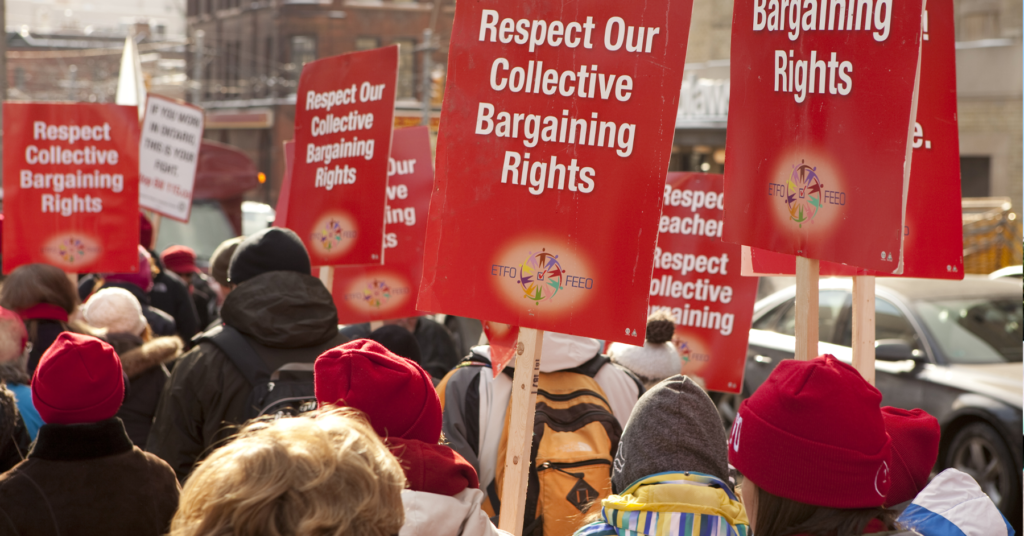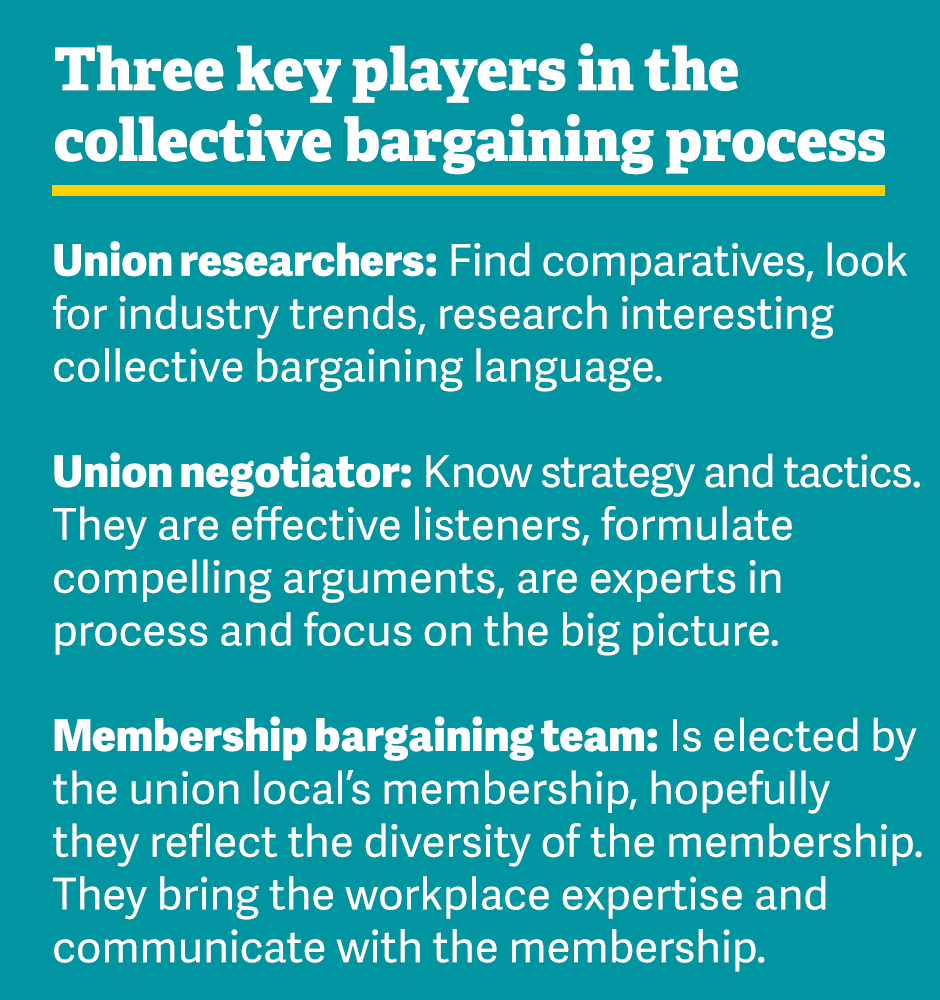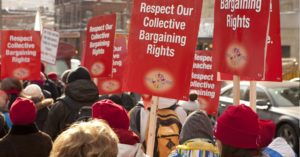
Here is What Everyone in Canada Needs To Know About How Collective Bargaining Really Works
We asked four union activists about how to establish strong collective agreements. Here’s what they said.
Imagine walking into your new workplace and being greeted by your shop steward, who guides you through your hard-fought collective agreement. They explain the evolution of the collective agreement, the renewal date, what they want to achieve next, and how you can get involved to help shape your local.
On the first day of her new job as a personal support worker in Ontario, Tamika was guided through the collective agreement, a legally binding contract that governs a worker’s relationship with their employer.
Kavya, the shop steward, was able to show Tamika the hard-fought evolution of their workplace, and the gains made with each round of collective bargaining. Tamika was invited to get involved in shaping the future of the workplace.
This is a high functioning local that wants to win strong collective agreements for years to come.

SEIU Healthcare
A collective agreement is a worker’s handbook for navigating the workplace. In order to build on the gains achieved in a collective agreement, active worker participation is necessary.
For this explainer on collective agreements, we interviewed four people: a union research officer, two union negotiators, and an elected bargaining team member.
Sheri Parent, president of PSAC Local 50262, spoke to the importance of understanding collective agreements:
“You stand taller, when you are more educated about your collective agreement! When you know your worth, when you know the value of your work. The value of you as an individual, your professionalism and what you bring to the table.”

What’s a collective agreement?
Brian Chang, a research officer with SEIU Healthcare, explains the importance of a collective agreement:
“Collective agreements are the core work of labour unions. they set out the expectations of workers and employers about how they are going to work together.”
The rules and process vary between sectors, jurisdictions and the size of the bargaining unit.
We’re excited to launch our brand-new member portal – Memberlink!
On this platform, you will be able to access our revamped online e-learning courses, update your contact information, view your collective agreement, and more!
To try Memberlink today: https://t.co/pAg4jTaCRY pic.twitter.com/Hk7sXvLzrN
— SEIU Healthcare (@SEIUHealthCan) August 12, 2020
Gathering Members Input and Research
Before the collective bargaining process starts, the union will seek input from its members on the main issues and priorities through a wide range of tools, including a survey. The local executives will hold at least one general meeting closer to the renewal date to deepen their understanding of members’ needs.
Laneydi Martinez-Alfonso, acting negotiator with PSAC, describes the qualities of a strong proposal package:
“A good demand names the problem, provides solutions to address the problem, and is accompanied with a strong rationale, comparatives, and any grievances to build the case. A bonus is a political climate aligned with worker needs to really be successful.”
While seeking input from its members, the researcher and or negotiator will audit the collective agreement for outdated policies and language, research comparators and compile a proposal package that keeps pace with worker protections and wages in the industry. The package will be organized into monetary and non-monetary demands.
According to Gail Lem, a negotiator with PSAC:
“We (negotiators) need to get an idea of the workplace – what the employees really need and what the impact is on them. Compelling stories accompanying the proposals and workplace visits helps the negotiators develop the best strategy and tactics.”
Set Realistic Member Expectations
Members need to be aware that this is a negotiation process. The employer will come with their demands as well. Members will not win everything, but for the most part, dignity, respect and decent wages are achievable.
Lem shares her wisdom on this:
“A collective agreement is a “living document” that allows you to respond, reflect, and advance the needs and interests of your membership. A first contract is like building a house. You have to establish a stable foundation so that the contract is secure and can stand the test of time. The rules must be clear for everyone. By contrast, money can always be built upon later.”
For the first contract, the focus needs to be on foundation-setting and curtailing the impacts of harm from the employer so the next round of bargaining can raise the bar. The bargaining team will be elected and review the proposal package to re-establish priorities, big impact demands and significant pressure points.
They will review the proposal package with the negotiators and researchers.
A notice to bargain will be served, usually from the union to the employer, up to four months in advance.
Highly mobilized and engaged locals is the ultimate objective in order to win strong contracts. Some locals show their power with supportive messages at work. Others enlist the support of community members to apply pressure on their employer. One of the more involved processes is “open bargaining,” where non-bargaining team members observe the bargaining process.
Strike Mandate
Martinez-Alfonso says: “To go to the table with a strong strike mandate is a very powerful tool to let the employers know that members are ready to take action.”
If an agreement is reached, the members vote to ratify the agreement. However, if there is an impasse, the negotiation process moves into conciliation, and a third party intervenes with a time limit to try to help reach an agreement between the two parties.
While the conciliation process is happening, the bargaining team mobilizes their members and tests their readiness to strike.
#tbt In 1991, PSAC members carried out the largest public sector strike in Canadian history over the then Conservative government’s proposed wage freeze. #canlab #cdnpoli pic.twitter.com/QG2EE7seFx
— PSAC-AFPC (@psac_afpc) October 3, 2019
Employer Tactics
Employers are not allowed to fire, harass or intimidate workers for unionizing, but that does not stop them from exploiting and creating divisions among workers. Some employers also use stalling tactics to drag out the process, and spread misinformation. All employers will test the appetite of the union to fight back, and employers have the advantage of money and power.
According to Gail, an experienced negotiator is able to “decipher what the employer needs versus what the employer wants,” which helps determine the bargaining team’s response to either accommodate or fight back.
How can anti-racism, anti-discrimination be built into collective agreements?
We asked this question of all our experts, and everyone agreed unions should be doing anti-racist work, and that there is more to be done.
Martinez-Alfonso said:
“Education is important but strong language in collective agreements along with accountability processes with timelines and goals is what makes anti-racism. As negotiators, we can build into bargaining team training on the importance of dealing with issues of racism in the workplace and why these issues should be kept at the table even if it is not the priority of the majority.”
Parent said:
“People of colour, us as racialized people, need to decide to be at the table. We can’t let others speak for us. I wish I knew before how much being part of (the bargaining team) would benefit me as a professional. Getting to meet other aspirational, intelligent, like-minded people from across Canada and you don’t realize how much this benefits you in your position.”
Our journalism is powered by readers like you.
We’re an award-winning non-profit news organization that covers topics like social and economic inequality, big business and labour, and right-wing extremism.
Help us build so we can bring to light stories that don’t get the attention they deserve from Canada’s big corporate media outlets.
Donate



